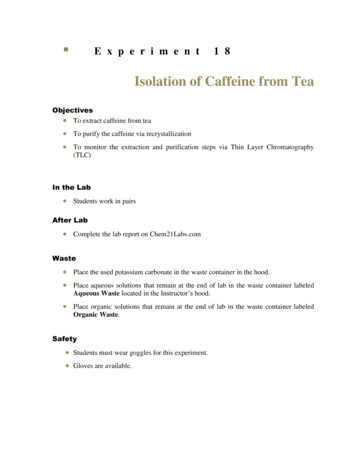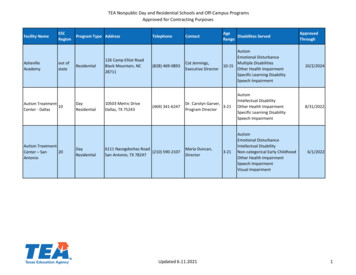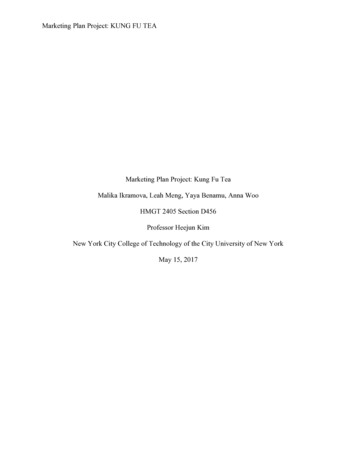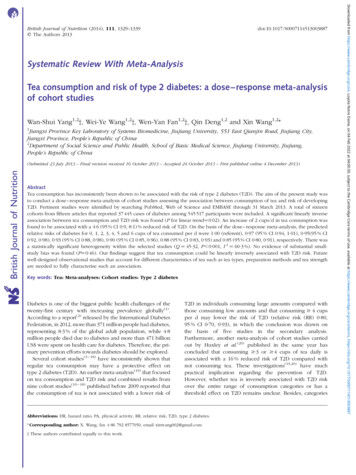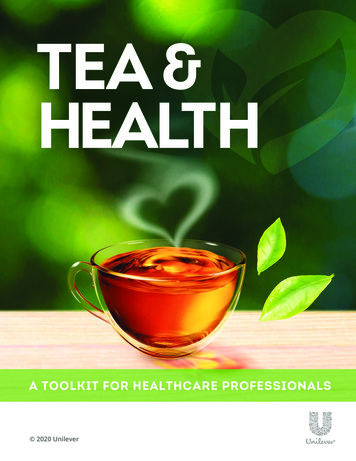
Transcription
TEA &HEALTHA TOOLKIT FOR HEALTHCARE PROFESSIONALS 2020 Unilever
TABLE OF CONTENTSTea and Health:A Toolkit for HealthcareProfessionalsIntroduction from Joy Dubost,Ph.D., RD, Head of Nutritionand Health, UnileverNorth AmericaPage 3Tea and Heart Health:Scientific EvidencePages 5-8Evidence-BasedBeverage Guidelinesto Improve Diet QualityPages 9-10Tea and Health:New Supporting EvidencePages 11-14Top Questions andAnswers on TeaPage 15 2020 Unilever2
Dear Health Professional,I am pleased to provide you with this educational toolkit highlighting recentresearch about brewed green and black tea and its role in heart health. Theinformation contained within is designed to offer evidence-based information,all substantiated by published, peer-reviewed science.As the world’s largest tea company, Unilever makes many of the most populartea brands including Lipton, Pure Leaf, TAZO, Pukka, PG tips, Red Rose, amongothers. We have been creating high-quality teas since the 1800s when SirThomas Lipton became a tea merchant in Scotland and later in New Jersey.Tea dates back thousands of years and is the most widely consumed beverage inthe world next to water. In addition to being as hydrating as water, teaprovides naturally occurring compounds, including lower levels of caffeinerelative to other caffeinated beverages (up to 50 mg/cup) and the bioactivecompounds, flavonoids. Tea is the one of the best contributors of flavonoidsin the diet — all of which make it a smart beverage choice.To better understand the benefits associated with drinking tea, Unilever hassponsored research at numerous universities to continue to advance theknowledge about tea and its impact on health.This educational toolkit provides: Scientific evidence supporting tea and heart healthKey findings from recently published tea studiesKey consumer messages about teaEvidence-based beverage guidelinesTop questions and answers on teaReferencesI hope you find this toolkit educational by providing you with morescientific evidence to help you offer sound recommendations onbenefits of tea consumption. If you would like more informationabout tea and health, please reach out to me directly.Sincerely,Joy Dubost, Ph.D., R.D.Head of Nutrition and Health, Unilever North AmericaJoy.dubost@unilever.com 2020 Unilever3
LIPTON BRAND PORTFOLIOLipton is one of the most trusted tea brands in the US with a diverse portfolio that offers something foreveryone! Its tea is grown with 4,000 hours of sunshine and its leaves are picked at the peak of freshness.As a result, each cup of Lipton tea has a naturally smooth and refreshing taste and aroma.And since it is one of the best sources of flavonoids – pour yourself another cup!24FAMILY SIZETEA BAGS24ICED TEpicked at THE peakof freshnessICED TEFAMILY SIZETEA BAGS 2020 UnileverSERVING SUGGESTIONNET WT 6 OZ (170g)SERVING SUGGESTIONNET WT 5.25 OZ (148g)4
TEA AND HEART HEALTH:Scientific EvidenceAll “true” tea originates from the Camilla sinensis plant. Processing conditions, including the amount oftime the leaves are exposed to the air or oxidized, determine the types of tea, including white, green,oolong, and black. White and green are made from green leaves before oxidation occurs. Oolong tea is madefrom partially oxidized leaves while black tea is totally oxidized. Herbal infusions like chamomile and gingerhave been traditionally labeled as “tea”; however, they are technically not true tea originating from theCamilla sinensis plant. Of note, all research cited in this toolkit are based on all types of tea originatingfrom the Camilla sinensis plant and not based on herbals or blends.Tea is the most widely consumed beverage in the world next to water. According to the Tea Associationof the U.S.A., tea is found in almost 80% of all U.S. households. In 2018, Americans consumed over 84 billion servingsof tea, or more than 3.8 billion gallons. About 84% of all tea consumed was black tea, 15% was green tea, and thesmall remaining amount was the other types of tea. Approximately 80% of tea consumed in America is iced.1TEA IS ONE OF THEBEST SOURCES OFFLAVONOIDS, whichare natural bioactivecompounds, presentin foods like wine,cocoa, fruit andvegetables, associatedwith health benefits.Green and black tea leaves naturally contain substances suchas flavonoids, theanine, caffeine and fluoride, but in differingquantities. Flavonoids are bioactive compounds naturally found ingreen and black tea, wine, cocoa, fruit and vegetables, with teabeing the major contributor in the diet.,2,3 Flavonoids have long beenassociated with multiple health benefits.4,5,6 For example, a systematicreview of 15 studies with more than 550,000 total participantsreported a 19% reduction in risk for cardiovascular disease (CVD)and a 13% reduced risk for death from CVD among those with thehighest intake of total dietary flavonoids, compared to the lowest.7A significant body of research concludes that drinking unsweetened,brewed green and black tea everyday can help support a healthyheart. Many observational studies, several clinicaltrials, as well as systematic reviews andmeta-analyses have found an association betweentea consumption and reduced risk of CVD. 8,9,10Significant and systematic scientific evidence indicatesthat the bioactive compounds, including flavonoids,s p e c i fi c a l l y t h e flavan -3 - ols , present in teacontribute to its cardiovascular benefits.The most comprehensive study to date on tea and CVD, sponsored by Unilever was published in Advancesin Nutrition entitled “Dose–Response Relation between Tea Consumption and Risk of CardiovascularDisease and All-Cause Mortality: A Systematic Review and Meta-Analysis of Population-Based Studies.”The authors of the study synthesized the global evidence on the relationship between tea consumption andrisks of all-cause mortality and CVD mortality, CVD events and stroke events among generally healthy adults,utilizing the methods outlined in the National Academy of Medicine’s Standards for Systematic Reviews.11 Sixdatabases were searched to identify scientific publications, including randomized clinical trials, prospectivecohort, and nested case control/case-cohort studies published through November 2019. Studies with dataon tea consumption and risk of incident CVD events (cardiac or peripheral vascular), stroke events andmortality, CVD specific mortality and all-cause mortality were included in the systematic review. Data from 39prospective cohort publications were synthesized. Linear meta-regression showed that each cup (236.6 mL)increase in daily tea consumption (estimated 280 mg and 338 mg total flavonoids/d for black and green tea,respectively) was associated with an average 4% lower risk of CVD mortality, a 2% lower risk ofCVD events, a 4% lower risk of stroke, and a 1.5% lower risk of all-cause mortality. 2020 Unilever5
Subgroup meta-analysis results showed that the magnitude of association was larger in elderly individuals for bothCVD mortality (n 4; pooled adjusted RR: 0.89; 95% CI: 0.83, 0.96; P 0.001), and all-cause mortality (n 3; pooledadjusted RR: 0.92; 95% CI: 0.90, 0.94; P 0.0001). Thus, in those 65 years and older, with each cup of tea consumedone could lower their risk of CVD mortality by 10%. The authors concluded based on the evidence, daily tea intakeas part of a healthy habitual dietary pattern may be associated with lower risks of CVD and all-causemortality among adults. Based on their results they stated the following: “Our systematic review providesevidence to begin developing dietary guidance and public health messaging around consumption of tea.” 12The preponderance of scientific evidence supports the position that tea flavonoids can be effective in promotingcardiovascular health. This data is robust and supports a case that unsweetened tea can be included as abeverage to encourage as part of a healthy dietary pattern. Incorporating tea as part of healthy diet is a simpledietary modification that may have positive public health implications on chronic disease risk reduction, specificallyCVD, the leading cause of death in the U.S. and globally. Nearly half of all U.S. adults have a form of CVD.About 647,000 Americans die from heart disease each year—that’s 1 in every 4 deaths.13 Drinking tea, in placeof sugar sweetened beverages or beverages with little or no health benefits, can be an effective strategy tohelp support a healthy heart and overall diet and lifestyle.Current science supports that drinking unsweetened green and black brewedtea everyday, hot or iced, CAN HELP SUPPORT A HEALTHY HEART.2-3LOWERSUGARINTAKEDaily consumption of 2-3 cups of unsweetenedbrewed tea providing 200-500mg of flavonoids canA healthy diet that includes a lower intake ofadded sugars is associated with aCUPSas part of a diet consistent with the DietaryGuidelines for Americans.reduced risk ofcardiovascular diseasein adults.0FLUIDNEEDShelp support a healthy heartCALORIESUnsweetened tea is agreat tasting, zero caloriebeverage that does notcontain added sugar. 2020 UnileverTea is99.5%waterand contributes to one’stotal fluid needs.6
A significant body ofresearch concludes thatdrinking unsweetened brewedgreen and black tea everydayCAN HELP SUPPORTA HEALTHY HEART.As noted earlier, the flavonoids in tea have been associated with the benefits of tea consumption as well as thefact that tea contributes to your total fluids needs and can help you stay hydrated. Unsweetened tea is azero-calorie beverage that does not contain added sugars which aligns with the current dietaryrecommendations. According to the 2015-2020 Dietary Guidelines for Americans a healthy diet that includesa lower intake of added sugars is associated with a reduced risk of cardiovascular disease in adults.14In general, the scientific evidence is clear that daily consumption of 2-3 cups of unsweetened brewedgreen or black tea providing between 200-500mg of flavonoids can help support a healthy heart aspart of a diet consistent with Dietary Guidelines.KEY TAKE-AWAYS: Tea is one of the best sources of flavonoids, which are natural bioactive compounds,present in foods like wine, cocoa, fruit and vegetables, associated with health benefits. People who drink 2-3, 8 oz. cups of tea per day may lower their risk of death fromheart disease by approximately 8-12%, compared to non-drinkers of tea. People who drink 2-3, 8 oz. cups of tea per day may lower their risk of all-causemortality by approximately 4-6%, compared to those who don’t drink tea. Each 8 oz. cup of tea consumed by those greater than 65 years old was associatedwith a 10% lower risk of death from heart disease. Daily consumption of two to three cups of unsweetened brewed tea providing200mg-500mg of flavonoids can help support a healthy heart as part of dietconsistent with Dietary Guidelines. 2020 Unilever7
REFERENCES1. Tea Association of the USA, Inc. Tea Fact Sheet, 2018 http://www.teausa.com/14655/tea-fact-sheet2. Ferruzzi MG, Tanprasertsuk J, Kris-Etherton P, et al. Perspective: The Role of Beverages as a Source of Nutrients and PhytonutrientsAdv Nutr 2019; 00:1–173. Wang Y, Chung SJ, Song WO, Chun OK. Estimation of Daily Proanthocyanidin Intake and Major Food Sources in the U.S. Diet. J Nutr; 141:447-452, 20114. Greyling, A.; Ras, R.T.; Zock, P.L.; Lorenz, M.; Hopman, M.T.; Thijssen, D.H.J.; Draijer, R. The effect of black tea on blood pressure: Asystematic review with meta-analysis of randomized controlled trials. PLoS ONE 2014, 9, e1032475. Kim, K.; Vance, T.M.; Chun, O.K. Greater flavonoid intake is associated with improved CVD risk factors in US adults. Br. J. Nutr. 2016, 115,1481–14886. McKay, D.L.; Blumberg, J.B. The role of tea in human health:An Update. J. Am. Coll. Nutr. 2002, 21, 1–137. Raman, G, Avendano E, Chen S. et al. Dietary intakesof flavan-3-ols and cardiometabolic health: systematic reviewand meta-analysis of randomized trials and prospective cohortstudies. Am J Clin Nutr. 2019 Nov 1:110(5): 1067-10788. Arab L, Khan F, Lam H. Tea consumption and cardiovasculardisease risk. Am J Clin Nutr 2013;98 (suppl):1651S–9S9. Balentine D, Wiserman SA, Bouwens LCM. The chemistry of teaflavonoids. Crit Rev Food Sci Nutr 1997; 37:693–70410. Vinson JA, Teufel K, Wu N. Green and black teas inhibitatherosclerosis by lipo, antioxidant, and fibrinolytic mechanisms.J Agric Food Chem 2005; 2:52(11):3661-511. National Academy of Medicine (US) Committee on Standardsfor Systematic Reviews of Comparative Effectiveness Research.Finding What Works in Health Care: Standards for SystematicReviews. (National Academies Press (US), 2011)12. Chung M, Zhao N, Wang D, et al. Dose-Response RelationshipBetween Tea Consumption and Risk of Cardiovascular Diseaseand All-Cause Mortality: A Systematic Review and Meta-Analysisof Population - Based Studies. Adv Nutrition. 2020 Feb 19:1–2513. Benjamin EJ, Muntner P, Alonso A, et al.Heart disease and stroke statistics—2019 update:a report from the American Heart Association.Circulation 2019;139(10): 56–52814. 2015-2020 Dietary Guidelines for t-dietaryguidelines/2015-2020-dietary-guidelines 2020 Unilever8
EVIDENCE-BASED BEVERAGE GUIDELINES TOIMPROVE THE DIET QUALITYBeverages have a role in hydration, and they also have an important role in meeting food group recommendations,essential nutrients, and bioactive compounds, all of which have a role in health.Beverages account for nearly 20 percent of the total calories in an average American diet, however publichealth recommendations, including the 2015-2020 Dietary Guidelines for Americans (DGAs), fail to highlight theimportance beverage choices have on meeting total dietary recommendations.1Simple swaps to consumers’ beverage choices can have significant impact in improving diet quality.Evidence-based beverage guidelines may help individuals meet the DGAs recommendations, including therecommended intake of specific nutrients, increasing the intake of bioactive compounds that promote health,and help decrease intake of nutrients to limit, including saturated fat and added sugars.1CHOOSING BEVERAGESWITH NO ADDED SUGARS SUCH ASUNSWEETENED TEA CAN HELPCONSUMERS REDUCE THEIR INTAKEOF ADDED SUGARCONSUMPTION ANDCONTRIBUTE TO AHEALTHYDIET.Current added sugar intake is just over 20% of total calories and sugar-sweetened beverages (SSBs) are a majorsource of added sugar in the U.S. diet. Recommendations to limit SSBs and shift to sugar- and calorie-freechoices like unsweetened tea or water can help consumers meet the Guidelines for added sugars of nomore than 10% of total daily calories.1For example, choosing beverages with no added sugars, such as water or unsweetened tea, in place of sugarsweetened beverages can help consumers reduce their intake of added sugar consumption and contribute to ahealthy diet. In addition, a healthy diet that includes a lower intake of added sugars is associated with a reduced riskof cardiovascular disease (CVD) in adults. What’s more, tea is a major contributor of bioactive compounds inthe diet, specifically flavonoids , which have been shown to be associated with health benefits, including supportinga healthy heart. 2,3 Considering the current mean intake of added sugars in the U.S. issignificantly higher than recommendations, substitution of one 8-oz sugar sweetenedbeverage with unsweetened tea would bring these averages significantly below therecommended added sugar limits while providing important flavonoids. 2020 Unilever9
Based on observational studies, randomized controlled trials, and meta-analyses, beverages can playan important role in the diet, such as those that deliver bioactive compounds, including tea, which isone of the best sources of flavonoids in the diet given the amount delivered per 8 ounce cup. 2 Althoughthese bioactive compounds, specifically flavonoids, lack a Dietary Reference Intake (DRI), their amounts fromcurrent intakes of fruits, vegetables, and whole grains fall short of beneficial health effects. Eight ounces of teadelivers an amount of flavonoids which exceeds 1 cup of commonly consumed fruits and vegetables. 2With regards to caffeine consumption the DGAs recommend a limit of 400mg of caffeine per day.1 Caffeine cancome from a variety of foods and beverages throughout the day. Black tea contains approx. half the caffeinecontent of brewed coffee. According to the USDA, black tea delivers 47 mg of caffeine per cup, green tea delivers28 mg of caffeine per cup, while brewed coffee delivers 95 mg of caffeine per cup. Keep in mind, brewed tea cancontribute to one’s total daily fluid needs. In fact, tea is 99.5% water, making it just as hydrating as water.DGAs are designed to provide consumers with guidance to eat a healthy dietary pattern that helps to reducethe risk of chronic disease, such as CVD. Beverages play an important role in meeting the overall DGAs fordaily recommended limits on total calories and added sugars, while providing specific nutrients and bioactivecompounds, including flavonoids. Providing specific guidance about beverages can help consumers more easilymeet the DGAs recommendations and may improve overall diet quality.REFERENCES1. US Department of Health and Human Services (US HHS) and USDA. 2015–2020 Dietary Guidelines for Americans[Internet]. 8th ed. Washington (DC): US HHS and USDA; December 20152. Ferruzzi MG, Tanprasertsuk J, Kris-Etherton P, Weaver CM, Johnson EJ. Perspective: the role of beverages as a sourceof nutrients and phytonutrients. Adv Nutr 2019;00:1–173. Raman G, Avendano EE, Chen S, Wang J, Matson J, Gayer B, Novotny JA, Cassidy A. Dietary intakes of flavan-3-ols andcardiometabolic health: systematic review and meta-analysis of randomized trials and prospectivecohort studies. Am J Clin Nutr. 2019 Nov 1;110(5):1067-1078 2020 Unilever10
TEA AND HEALTH:New Supporting EvidenceJournal: Nutrients 2019;11, 2635 doi:10.3390/nu11112635Unilever Sponsored Research1Title: TEA CONSUMPTION PATTERNS IN RELATION TO DIET QUALITY AMONGCHILDREN AND ADULTS IN THE UNITED STATES:analyses of NHANES 2011–2016 dataAuthors: Vieux F, Maillot M , Rehm CD. Drewnowski AAbstractFlavonoid-rich tea offers an alternative to sugar-sweetened beverages. Thepresent analyses, based on 2, 24-hour dietar y recalls for 17,506 persons aged 9 years old in the 2011–2016 National Health and Nutrition Examination Surveydatabase (NHANES 2011–2016), explored tea consumption patterns in relation todemographics, diet quality, cardiovascular disease (CVD) biomarkers (lipids andblood pressure), and body weight. Beverage categories were unsweetened tea,other tea (herbal and presweetened tea), coffee, milk, 100% juice, water and otherhigh-calorie (HC) and low-calorie (LC) beverages. Tea consumption (18.5% of thesample) was highest among older adults (51–70 years old), non-Hispanic Asiansand Whites, and those with college education and higher incomes. The effects ofage, gender, education, income, and race/ethnicity were all significant (p 0.001for all). Adult tea consumers had diets with more protein, fiber, potassium,iron, and magnesium, and less added sugars and alcohol. Their dietscontained fewer HC beverages and coffee but had more total and citrus fruit,more total dark green and orange vegetables, and more seafood, eggs, soy andmilk. Tea consumers had higher Healthy Eating Index (HEI-2015) and higherNutrient-Rich Foods (NRF9.3) nutrient density scores. Few children drank teaand no differences in diet quality bet ween consumersand non-consumers were observed. Adult teaconsumers had slightly higher high-densitylipoprotein (HDL) cholesterol and lower bodymass index (BMI) values. Tea consumption wasassociated with higher socioeconomic status andbetter diets. 2020 Unilever11
KEY FINDINGS On any given day, about 20% of U.S adults drink tea. There is an association between regular tea consumption and healthier diets,more similar to the recommendations set out by the Dietary Guidelines of Americans. Tea drinkers consumed more protein, fiber, select vitamins and minerals (vitamin E,potassium, iron and magnesium) and had diets lower in added sugars and alcohol. Tea consumers had a healthier dietary pattern with higher consumption of totalfruit and vegetables, eggs, soy, oils, seafood, and milk. Tea consumption was associated with higher good cholesterol (HDL) and lowerbody mass index (BMI) values (lower body weight).TEA CONSUMPTIONWAS ASSOCIATEDWITH HIGHERGOOD CHOLESTEROL(HDL) AND LOWERBODY MASS INDEX(BMI) VALUES(lower body weight). 2020 Unilever12
TEA AND HEALTH:New Supporting EvidenceJournal: Advances in Nutrition 2020; 00:1–252Title: PERSPECTIVE: the role of beverages as a source of nutrients andphytonutrientsAuthors: Ferruzzi MG, Tanprasertsuk J, Kris-Etherton P, Weaver CM, Johnson EJAbstractThe Dietary Guidelines for Americans (DGA) provide nutrition advice for Americans 2 y of age. The 2020–2025 DGA proposes a life stage approach, focusing on birththrough older adulthood. Limited recommendations for beverages exist except formilk, 100% fruit juice, and alcohol. The goal of this article is to provide a betterunderstanding of the role of beverages in the diet using current scientific evidence.A Medline search of obser vational studies, randomized controlled trials, andmeta-analyses was undertaken using key beverage words. We highlight the rolebeverages can play as a part of the DGA and considered beverages not traditionallyincluded, such as those that are phytonutrient dense. Our primary considerationfor beverage consumption targeted healthy Americans aged 2 y. However, withthe proposed expansion to the life span for the 2020–2025 DGA, we alsoreviewed evidence for infants and toddlers from birth to 24 mo. Examples areprovided on how minor changes in beverage choices aid in meeting recommendedintakes of certain nutrients. Guidance on beverage consumption may aid in developmentof better consumer products to meet broader dietary advice. For example, beverageproducts that are nutrient/phytonutrient dense and lower in sugar could be developed asalternatives to 100% juice to help meet the fruit and vegetable guidelines. Althoughbeverages are not meant to replace foods, e.g., it is difficult to meet the requirements for vitamin E, dietary fiber, or essential fatty acids through beverages alone,beverages are important sources of nutrients andphytonutrients, phenolic acids and flavonoids inparticular. When considering the micronutrients from dietalone, mean intakes of calcium (in women), potassium,and vitamins A, C, and D are below recommendationsand sodium intakes are well above. Careful beveragechoices could close these gaps and be considered ap ar t of a heal t hy die t ar y p at ter n. 2020 Unilever13
KEY FINDINGS Eight ounces of green or black unsweetened tea delivers flavonoids in theamount which exceeds 1 cup of commonly consumed fruits and vegetables. Minor changes in beverage choices can help in meeting recommendedintakes of certain essential as well as nonessential nutrients, like flavonoids. Re p la cin g s u gar- s we e te n e d b e ve ra ge s f r o m s o da o r e n e r g y dr in k sw i t h wa te r o r un s we e te n e d te a w ill h e lp r e d u ce a d d e d s u gar s an de mp t y c al o r i e s to r e co mm e n d e d l e ve l s . 2020 Unilever14
TOP FIVE QUESTIONS COMMONLY ASKED:Q: How does Lipton green and black tea help maintain a healthy heart?Lipton green and black tea with no sugar added can help maintain a healthy heart in severalways. First, unsweetened tea is more than 99% water and can contribute to people’s dailyfluid requirement. Proper hydration is important for circulatory functions. In addition, theDietary Guidelines for Americans and FDA indicate that a lower intake of added sugars isassociated with a reduced risk of cardiovascular disease in adults. Plus, daily consumption ofat least 200-500 mg of flavonoids can help maintain a healthy heart as part of a diet consistentwith Dietary Guidelines. Tea can be a major source of flavonoids in the diet.Q: Are there different health benefits associated with green and black tea?Both green tea and black tea come from the Camellia sinensis plant. Because they come fromthe same plant, green and black teas both contain the same components, such as flavonoids,caffeine, fluoride, and theanine. However, the component levels may vary between green andblack tea. Based on results from current scientific studies, we know that the health benefits,including cardiovascular health benefits from drinking green and black teas, are comparable.Q: Does decaffeinated green and black tea contain flavonoids?Decaffeinated green and black tea also contains flavonoids. However, during thedecaffeination process some flavonoids in tea are lost. Therefore, decaffeinated teascontain less flavonoids than regular teas.Q. What is the flavonoid content of regular green and black tea?We currently test our Lipton regular green and black teas for flavonoids,which are a type of polyphenol. Brewed Lipton100% Natural Green Tea contains about 150mgof flavonoids per 8 fl oz cup. Brewed LiptonBlack tea contains about 170mg offlavonoids per 8 fl oz cup.Q. Will brewing tea in hot or coldwater impact flavonoid levels?Hot water used to prepare the tea will allowmore flavonoids to dissolve in the brew.Consumers should follow brew instructionson pack for best taste and quality. 2020 Unilever15
TEA PREPARATION INSTRUCTIONS:TASTES GREATorTRY IT HOTFill a cup with boilingwater and add 1 teabag*1.2.3-5Steep for 3-5 minutesMINAdd milk if desiredand sweeten to taste3.LIPTON QUICK CHILL METHOD1.Fill half a pitcher withboiling water, and add4 teabags for 3 minutes2.Fill the rest of thepitcher with ice3.Enjoy now, orrefrigeratefor later*Do not microwave teabag 2020 Unilever16
Tea is one of the best sources of flavonoids, which are natural bioactive compounds, present in foods like wine, cocoa, fruit and vegetables, associated with health benefits. People who drink 2-3, 8 oz. cups of tea per day may lower their risk of death from heart disease by approximately

